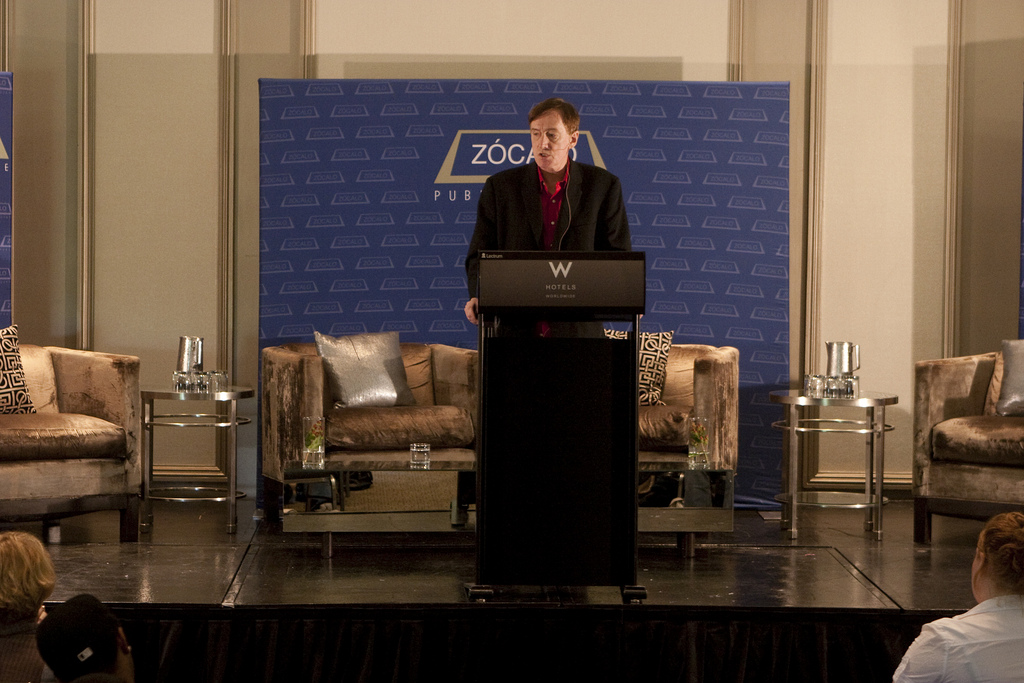
“In New Orleans, you gotta start with music,” said Ned Sublette, before singing a tune by James Andrews: “One, Two, What You Gonna Do?”, on the response, or lack thereof, to Hurricane Katrina.
Sublette was the keynote speaker for Zócalo’s conference, La Nueva Orleans? Race and Immigration in Post-Katrina America, generously supported by the Carnegie Corporation of New York. Before two panels took the stage to address present day race relations and immigrant integration in America, Sublette told a brief history of the city he has chronicled in two books to the crowd at the W New Orleans, including his most recent, The Year Before the Flood: A Story of New Orleans.
Keynote Speaker: Ned Sublette, “Whatcha Gonna Do?”
Sublette spent 2004 and the early part of 2005 in New Orleans. Sublette’s adopted hometown of New York has a multicultural reality, he said, but New Orleans has always been black and white. When he arrived, “I felt like, ‘Oh shit, I’m a white person now,’” he joked. “I hate it when that happens.” He described New Orleans as “traumatized not once but repeatedly, not only from physical disaster but from the ongoing legacy of slavery. . . a black island with a white state on one side and the sea at its back.”
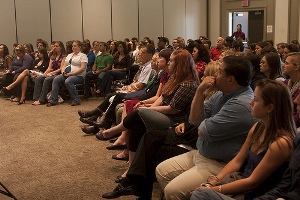 Today, the Latino population is small but growing, and gaining visibility: since the flood, Sublette said, taco trucks have become a fixture, so much so that the predominantly white suburb of Jefferson Parish banned them in 2007, citing health concerns. Most Latino immigrants came because of the need for cheap labor, once provided by the city’s African Americans. “New Orleans was largely built by first enslaved and subsequently dirt cheap black labor,” Sublette said. New migrant laborers, unlike American workers with families, didn’t need many social services, which were of course not forthcoming after the flood.
Today, the Latino population is small but growing, and gaining visibility: since the flood, Sublette said, taco trucks have become a fixture, so much so that the predominantly white suburb of Jefferson Parish banned them in 2007, citing health concerns. Most Latino immigrants came because of the need for cheap labor, once provided by the city’s African Americans. “New Orleans was largely built by first enslaved and subsequently dirt cheap black labor,” Sublette said. New migrant laborers, unlike American workers with families, didn’t need many social services, which were of course not forthcoming after the flood.
By the summer of 2008, Sublette said, New Orleans was back up to 72% of its former population, but only about 63% of African Americans had returned. Many are still trying. Construction continues, and the sound of spoken Spanish is a familiar one.
Hearing Spanish isn’t particularly new for New Orleans, Sublette noted. Louisiana was a Spanish colony, the only one Spain acquired rather than created. Though Spanish never dominated the French language, Spanish-speaking and English-speaking people came in then. In 1803, Napoleon did reacquire Louisiana, only to hand it off to Thomas Jefferson. “Suddenly it was the deep South,” Sublette said, “It had been el Norte the day before. Today it’s both el Norte and the bottom of the map.”
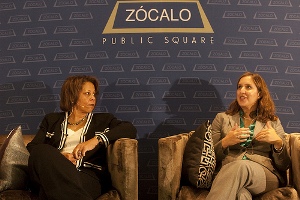 On the heels of the World’s Cotton Centennial in 1884, New Orleans imported its first saxophone player from Mexico. Mexican music swept the city, and had great impact in the days before jazz. Spanish music helped form the rhythm of ragtime and the jelly roll (traces of which can still be heard in reggaeton – “The same beat has been bouncing around for 300 years,” Sublette said). Many Mexicans relocated to New Orleans. In the 19th century, Sublette noted, New Orleans was the second major immigrant destination in America after New York, and tied with Baltimore as the second largest city in the U.S. Even in present day, before 2005, the Latino population was small but certainly present, particularly the Honduran community.
On the heels of the World’s Cotton Centennial in 1884, New Orleans imported its first saxophone player from Mexico. Mexican music swept the city, and had great impact in the days before jazz. Spanish music helped form the rhythm of ragtime and the jelly roll (traces of which can still be heard in reggaeton – “The same beat has been bouncing around for 300 years,” Sublette said). Many Mexicans relocated to New Orleans. In the 19th century, Sublette noted, New Orleans was the second major immigrant destination in America after New York, and tied with Baltimore as the second largest city in the U.S. Even in present day, before 2005, the Latino population was small but certainly present, particularly the Honduran community.
The immigrant boom waned in the 1920s due to federal policy; labor regulations strengthened workers’ rights and ended cheap labor, for a time. When legal immigration surged again in the 1960s, Sublette said, New Orleans was left out. The city was in economic decline – people chose airplane cities like Houston, Miami, and Los Angeles over old port cities. Another crucial and often overlooked factor in New Orleans’ decline, Sublette argued, was the end of trade with Cuba. Reopening trade with that country, Sublette said, would do wonders for New Orleans’ economy. “An embargo of Cuba is an embargo of New Orleans.”
—————————————————————————————————————
Watch the video of Sublette’s speech, “Whatcha Gonna Do” here, or a brief clip here.
Read our In The Green Room Q&A with Sublette here.
Read an excerpt from The Year Before the Flood here, and buy the book here.
—————————————————————————————————————
Panel One: Is Black-Brown the New Black-White?
The first panel began to explore whether black-brown is the new black-white by first showing how difficult racial categories are to parse. Oscar Garza, a veteran journalist of culture and music, moderated the discussion between Duke’s Paula McClain, Louisiana State University’s Betina Wilkinson, and USC Annenberg’s Roberto Suro, and began by noting the complex racial makeup of Latinos.
Check ‘Other’
After Cortes came to Mexico in 1519, Garza explained, 200,000 African slaves were sent. Intermixing between them, the Spanish, and the Indians led to a racially mixed society but, Garza said, one that still discriminated against blacks. Slavery was abolished in 1810, but persevered in the northern territories that would become Texas-the first Mexican Americans held a prejudice against black people, Garza said.
 Today’s American race relations may involve milder prejudices, but just as much confusion. For one thing, “There are a much greater variety of ways of being nonwhite than there ever were before,” Suro said, driven by the growth of Latino and Asian populations and the development of black professional classes. “The designation of nonwhite is a bit too all-inclusive to have meaning.” Within the Latino community, race is still as convoluted as ever, Suro added. Forty-four percent of Latinos mark “some other race” on Census forms; the other large portion of Latinos marks white. Those who do identify as white, he said, tend to be native-born, well-educated English speakers. “Whiteness has a meaning,” he said. Wilkinson noted that while she identifies as Latino, her sister identifies as white.
Today’s American race relations may involve milder prejudices, but just as much confusion. For one thing, “There are a much greater variety of ways of being nonwhite than there ever were before,” Suro said, driven by the growth of Latino and Asian populations and the development of black professional classes. “The designation of nonwhite is a bit too all-inclusive to have meaning.” Within the Latino community, race is still as convoluted as ever, Suro added. Forty-four percent of Latinos mark “some other race” on Census forms; the other large portion of Latinos marks white. Those who do identify as white, he said, tend to be native-born, well-educated English speakers. “Whiteness has a meaning,” he said. Wilkinson noted that while she identifies as Latino, her sister identifies as white.
Competition and violence
Though prejudices are milder, race and racial perceptions count when it comes to competition between African Americans and Latinos. “I lost a job, you came, I no longer have a job,” McClain said, describing the logic that leads to a sense of competition. That is, even when immigrant communities aren’t to blame for the loss of jobs or social services – when in fact it’s the economy, or a state legislature, as was the case in McClain’s Durham – some may perceive that new immigrants are to blame. Similar class status, McClain said, can also lead to a heightened sense of competition, rather than to the increased cooperation that might be expected. Wilkinson noted that from her research, those who say there is competition between groups are likelier to be from a lower socioeconomic status group.
What also provokes a sense of competition, Suro said, is the speed of growth in an immigrant community, and in what neighborhoods that growth occurs. In Los Angeles, he noted, immigrants have moved into historic black neighborhoods in large numbers. And the city is often worried about violence between the two groups, even though violence is easy to exaggerate, he noted. “Everywhere in the country 90% of murders are committed within the same racial group.” Other than that, Suro said, violent behavior among young men is spurred by the incarceration policy – putting too many men into too few prisons. “It’s really important not to generalize from very dramatic events to the rest of these populations.”
Indeed, the panelists noted that African Americans have a more favorable attitude toward Latinos, and a better perceived relationship with them, than Latinos do. African Americans do, however, have more negative views on whites.
The vote
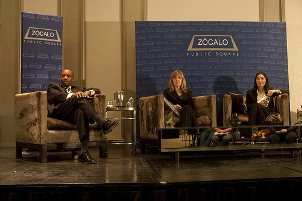 Generally, laborers moving to New Orleans have been single men. But immigrant communities become permanent, and more diverse in gender and age, in a “totally predictable” way, Suro said. “You have to start planning for expanding your Kindegarten classes and hiring ESL teachers in seven to 10 years. It happens like clockwork.” By then, Suro said, immigrant workers will either leave, or relocate their families. While the growth of male workers alone is a small burden on social services, families do require more services. In the current economic climate, Suro said, it’s still not certain people are returning home. And in the past, immigrants simply rode out recessions, even if they’re desperate enough for work to crave any job, no matter why it opened up: Wilkinson noted that one worker she interviewed said under his breath, “I hope another hurricane comes in because we’ll have more work.”
Generally, laborers moving to New Orleans have been single men. But immigrant communities become permanent, and more diverse in gender and age, in a “totally predictable” way, Suro said. “You have to start planning for expanding your Kindegarten classes and hiring ESL teachers in seven to 10 years. It happens like clockwork.” By then, Suro said, immigrant workers will either leave, or relocate their families. While the growth of male workers alone is a small burden on social services, families do require more services. In the current economic climate, Suro said, it’s still not certain people are returning home. And in the past, immigrants simply rode out recessions, even if they’re desperate enough for work to crave any job, no matter why it opened up: Wilkinson noted that one worker she interviewed said under his breath, “I hope another hurricane comes in because we’ll have more work.”
Meanwhile, what happens with federal immigration policy will impact the political import of this population – though it seems immigration reform is unlikely to pass soon. African Americans supported immigration reform in the 1980s, Suro noted, but it’s hard to say how they will vote this time. Meanwhile, as African Americans gain political clout, the Latino population has less political power per capita because of undocumented immigrants. If a large number of Latinos do become citizens, McClain noted, it might be “a nice lifesaver” in Southern jurisdictions for Democratic politicians, or it may create a backlash against immigrants by both white and black southerners.
—————————————————————————————————————
Watch a video of the first panel, “Is Black-Brown the New Black-White?” here, or a brief clip here.
Read In The Green Room Q&As with the panelists at the following links:
Oscar Garza, Paula McClain, Betina Wilkinson, Roberto Suro
—————————————————————————————————————
Panel Two: What Do Latinos Mean for Civil Rights?
Early in the second panel, population geographer Anita Drever explained why immigrants would want to move to the South.
Asked by moderator Andre Perry of the University of New Orleans why immigrants would want to move to the South, a region with a long legacy of poor labor conditions, Drever replied, “Everybody’s realizing they don’t want to live in Los Angeles.”
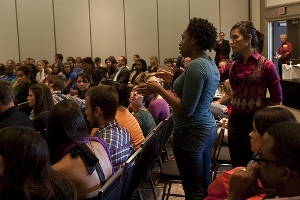 Drever and Perry joined Syracuse’s Jamie Winders and Stanford’s Laura López-Sanders to explore why immigrants are moving South, how this is changing the image of the South and the legacy of the civil rights movement, and how new migrants experience race and racism.
Drever and Perry joined Syracuse’s Jamie Winders and Stanford’s Laura López-Sanders to explore why immigrants are moving South, how this is changing the image of the South and the legacy of the civil rights movement, and how new migrants experience race and racism.
Leaving Los Angeles
Drever explained why the South seems more attractive than traditional immigrant destinations today. Markets in places like Los Angeles are saturated; communities are moving together to new locations. Drever studied one town outside of Knoxville, where workers moved from Pennsylvania for the $11-an-hour wage, the 401(k) plans, and the low housing prices, of about $400 a month for a one bedroom. Middle men, too, recruit labor, as they did in New Orleans after Hurricane Katrina. The result, Drever said, is an utterly new immigration pattern that changes communities very quickly, and that can be seen throughout the South. Latino laborers are sometimes also recruited specifically to replace African American workers, as López-Sanders found in one factory she studied. But, she said, “The dynamics are not very well known. We know this happens – replacement and displacement – but we don’t know exactly how.” That makes it difficult to make a discrimination claim, or even to align with an advocacy group for help, leaving displaced workers with little resource.
Another trend is that women are migrating alone from new places – like the Mexican states of Oaxaca, Veracruz, Hidalgo, and Durango – and starting families in the U.S., López -Sanders noted. They’re becoming a large part of the Latino labor force, particularly in those industries that “have become very feminized.”
The new South
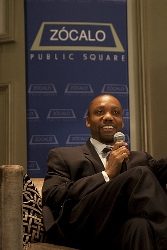 The mass migration creates tension between the two dominant American narratives, Perry noted: the civil rights struggle – that is, the relationship between blacks and whites-and the nation of immigrants. Civil rights in the South, he said, “are driven around a black agenda,” from voting issues, labor, and discrimination. In some cases, immigrants have explicitly adopted the legacy, Winders noted. The 2003 Immigrant Workers Freedom Ride “literally mapped onto the geography of the original Freedom Ride,” she said. But despite their use of symbolic sites and spaces, some immigrants, and particularly the undocumented, don’t feel comfortable claiming public space, Drever said. Even in a city like New Orleans, which has many monuments to the city’s historical relationship with Latin America, immigrants rarely risk claiming space, she said.
The mass migration creates tension between the two dominant American narratives, Perry noted: the civil rights struggle – that is, the relationship between blacks and whites-and the nation of immigrants. Civil rights in the South, he said, “are driven around a black agenda,” from voting issues, labor, and discrimination. In some cases, immigrants have explicitly adopted the legacy, Winders noted. The 2003 Immigrant Workers Freedom Ride “literally mapped onto the geography of the original Freedom Ride,” she said. But despite their use of symbolic sites and spaces, some immigrants, and particularly the undocumented, don’t feel comfortable claiming public space, Drever said. Even in a city like New Orleans, which has many monuments to the city’s historical relationship with Latin America, immigrants rarely risk claiming space, she said.
In other instances, more clear competition can result, Winders noted. For example, many state contracts have minimum “set-asides” for businesses run by minorities – which primarily means African American, and which came about as a result of long political struggle. Latino business owners might seek to be defined as minorities to compete for those contracts.
The local border
 Still, direct competition between African Americans and Latinos for jobs is just beginning to be understood, the panelists agreed. But tensions can fire up, Winders noted, often in response to symbolic or purely personal incidents occurring in “the very intimate spaces of daily life,” like seeing a Mexican flag posted outside a neighboring house. “There is a slippage between defending a neighborhood, and national heritage or national security,” she said. Politicians in the South run on the border issue “as a local issue,” Winders said. Anti-immigrant language and sentiment can fit neatly into the agendas of hate organizations.
Still, direct competition between African Americans and Latinos for jobs is just beginning to be understood, the panelists agreed. But tensions can fire up, Winders noted, often in response to symbolic or purely personal incidents occurring in “the very intimate spaces of daily life,” like seeing a Mexican flag posted outside a neighboring house. “There is a slippage between defending a neighborhood, and national heritage or national security,” she said. Politicians in the South run on the border issue “as a local issue,” Winders said. Anti-immigrant language and sentiment can fit neatly into the agendas of hate organizations.
But, Winders added, the South relies heavily on foreign investment, and anti-immigrant measures like English-only ordinances can be seen as regressive. And ultimately, as Drever said, even the undocumented population will need to be somehow accepted – they make up a sizable portion of the U.S. workforce, and they’re unlikely to leave en masse. Without immigration reform, she said, “We are changing what it means to be an immigrant in this country, to the detriment of immigrants and the country.”
—————————————————————————————————————
Watch a video of the second panel, “What Do Latinos Mean for Civil Rights?” here, or a brief clip here.
Read In The Green Room Q&As with the panelists at the following links:
Andre Perry, Jamie Winders, Laura López-Sanders, Anita Drever
—————————————————————————————————————
More coverage:
See photos here.
Read The New Orleans Times-Picayune’s story here.
*Photos by Andy Levin.




Send A Letter To the Editors